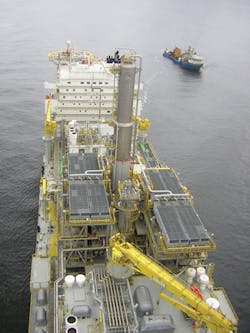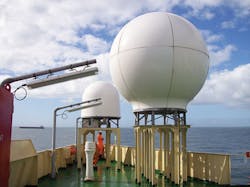Rolf Berge
Harris CapRock
The need for innovation continues to grow as revenue decreases within the oil and gas industry. Companies that once thrived in the relatively conservative market are now being forced to update software and technology to keep up with competitors.
With the move toward technological innovation, IT resources and service needs are forecast to continue to rise despite an oil market slump. In the US, more than 30 to 50 thousand annual wells have been drilled onshore in recent years, which is allowing for more innovation and experimentation, some of which is being adapted offshore.
At the same time, the industry is experiencing a generational change as more and more oilfield veterans move into retirement. This change in decision makers and need for innovation is making the industry less conservative and is forcing companies to look for new ways to do business – which directly correlates to an increase in communication needs.
For example,FPSOs have been employed for several decades and, as a result, require a large investment in remote communications. As the industry makes way for a new generation of digitally savvy decision makers, communication, collaboration, and connectivity are key to success for FPSOs when transferring big data across limited bandwidth and maintaining an experienced workforce.
Connectivity on the move
While FPSOs tend to be less mobile than traditional deepwater vessels, they are not considered stationary elements as with land-based operations. Though they may remain relatively stationary in their location, these vessels are subject to severe weather. They swing to move with the wind and tide, and thus experience quite a bit of pitch and roll in the ocean.
Unlike mobile offshore drilling rigs, a deepwater production platform, such as an FPSO, is in place for decades, which typically results in greater investments in communications.
Because of the extended length of time an FPSO is placed in a specific location, it is easier for the operator to understand the cost savings that can be realized by investing in updated communications technology. Since rigs may only be active for a few years before decommissioning and recommissioning, the need for updated communications is often pushed aside to make way for other costs. With the extended lifespan of an FPSO, communication and the ability to pass along big data become a vital part of daily operations, making it easier and more cost-efficient to invest in updated communication technology. Due to this, the industry is seeing an upward trend in terms of both reliability and bandwidth needs.
Technological improvements
New technology, coupled with additional bandwidth, will be used to improve crew morale, operational efficiency, and real-time data gathering and monitoring. In addition, upgrades in communication reliability will boost crew safety and reduce costs.
Operational efficiency
Productivity and operational efficiency go hand-in-hand. By investing in communication technology, operators are keeping up with the drive toward big data and automation. Even with the downturn, product lines that incorporate automation have experienced a 40% growth, while every other product line has dropped.
Enhancing connectivity and communication provides FPSOs the ability to transmit large caches of data across bandwidth and in turn, increases productivity, operational efficiency, and crew welfare, as they are able to push data monitoring off-vessel and reduce the number of crew members needed for those operations.
Adding automation not only enhances predictability, but is also another way companies can increase safety and reduce the number of crew members needed on the vessel – saving the company around a million dollars a year per person that can be removed.
Simultaneously, the layoffs that have occurred recently have increased the need to retain the industry’s more experienced workers. Which is where maintaining crew welfare and morale becomes essential.
Crew welfare
Technological improvements in communication on FPSOs will not only impact the overall safety, but also the morale of crew members on these vessels by increasing connectivity. In this digital age, more people expect to be able to connect to their friends and family, no matter the time or place. Previously, this was a difficult situation to manage for operators, as FPSOs are constantly moving with the tide and may not necessarily be within a given network depending on location. With advances in communication technologies, operators are able to provide this must-have connectivity and in turn are able to retain experienced employees, as well as attract new generations of workers.
Case study
Recently, a major worldwide FPSO vessel operator approachedHarris CapRock for help in improving the efficiency of its operations. At the time, the operator was facing three major issues:
Inconsistent bandwidth use. The operator frequently noticed inconsistent bandwidth usage. At times they would pay for bandwidth that they did not end up using, and other times they would not have enough.
Crew bandwidth prioritization. The crew on the vessel was regularly using more bandwidth than planned, and they had no way of adjusting availability based on priority.
Analytic needs vs. budget restrictions. As the need for analytics grew and budgets tightened, they struggled to effectively manage and process information from injection lines, existing well centers, drilling platforms, and visiting tankers. They quickly realized that there was too much information to process and not enough crew to effectively monitor it.
To resolve these issues, Harris CapRock implemented an uncontended Time Division Multiple Access (TDMA) network. Most TDMA networks are contended, but this type of network allows a number of installations to access a single pool of bandwidth. This causes performance to slow to unacceptable levels, and therefore makes this style of network an unsuitable choice. With the uncontended TDMA network, there is enough bandwidth allocated so that every user receives their committed amount of bandwidth with no chance of it being unavailable (as with a contended network). This also provides bursting capability – so if there is unused bandwidth available on the network, it can be used to temporarily boost performance.
Additionally, Harris CapRock worked with the FPSO operator to set up Quality of Service (QoS) policies. These affect a network’s ability to achieve maximum bandwidth and deal with network performance elements like latency, error rate, and uptime. QoS policies are a set of rules that give prioritization to important traffic over less critical traffic. An effective QoS policy lets users give priority to specific applications; prevents bandwidth hogging; and helps manage network bottlenecks.
These policies enabled the operator to prioritize bandwidth based on need. For instance, if an important video conference with management was required, the bandwidth could be allocated to prioritize that meeting over crew internet access. The same could be applied in the opposite direction. If there was rough weather that might concern families of the crew, more bandwidth could be allocated to allow the crew to contact and reassure family.
In addition to the change in network, the majority of the monitoring and analytic duties were moved onshore to a central location. This improved safety and efficiency by minimizing the number of onboard crew and allowing fewer employees to complete the necessary tasks.
The offshore oil and gas industry is increasingly moving toward remote communications, and FPSO operators have been able to show leadership on this front that puts them ahead in the market. The latest communications technologies are enabling them to increase productivity and reliability by achieving better communications, better connectivity, and better collaboration.
The authorRolf Berge is Chief Technology Officer, Harris CapRock. In that role, he oversees the overall technology strategy to ensure alignment with the company’s product and service portfolio as well as with its global satellite, wireless, and terrestrial network infrastructure. Berge plays a key role in the selection of technology and solutions to ensure highly performing networks. Prior to this, he held various positions with Schlumberger in operational and technology leadership roles prior to joining Harris Corporation in 2011. While with Schlumberger, he had responsibility for global network engineering and the real time infrastructure. Berge holds a bachelor’s degree in electronics and telecommunications from the University of Strathclyde, Glasgow, UK. He has over 25 years of experience in the industry.






